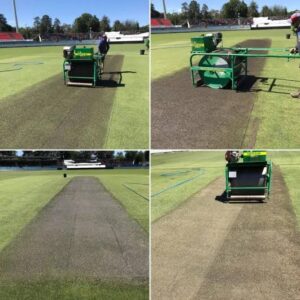Preparing a cricket pitch is a meticulous process that requires careful attention to detail to create a safe and even playing surface.
Here’s a step-by-step guide on how a cricket pitch is prepared:

1. Soil Preparation: The soil is tested to determine its composition and moisture level. The ideal soil for a cricket pitch is a mixture of clay, silt, and sand.
2. Laying the Pitch: The soil is then laid on the pitch area, and a layer of clay is applied to create a firm and even surface.
3. Rolling: The pitch is rolled using a heavy roller (around 1-2 tons) to compact the soil and remove any air pockets. This process is repeated several times to achieve the desired density.
Follow us on Instagram
4. Watering: The pitch is watered to maintain the optimal moisture level (around 20-25%). This helps to keep the soil firm and prevent it from becoming too dry or too wet.
5. Mowing: The grass is mowed to a height of around 10 mm to create an even surface.
6. Marking: The pitch is marked with creases (lines) and a center square using a mixture of chalk and water.
7. Covering: The pitch is covered with a tarpaulin or plastic sheet to protect it from rain and excessive sunlight.
Final Preparation step for a Cricket Pitch
Before each match, the pitch is inspected, and any necessary repairs are made. The pitch is then watered and rolled to create a smooth and even surface.
How the Maintenance of the Cricket Pitch is being carried out?
Throughout the season, the pitch is regularly maintained by mowing, watering, and rolling to keep it in good condition.
Some additional factors to consider for Preparation of a Cricket Pitch
1- Pitch Type: There are two main types of pitches: natural (made from natural soil) and artificial (made from synthetic materials).
2-Grass Type: The type of grass used on the pitch can affect the playing surface. Common types include perennial ryegrass, Bermuda grass, and Kentucky bluegrass.
3-Weather Conditions: Weather conditions can impact the pitch preparation process. For example, heavy rain may require additional rolling to remove excess water.
– Pitch Dimensions: The pitch dimensions must meet ICC standards (20.12 meters x 3.33 meters for international matches).
Also Read : The impact of AI in Cricket
By following these steps, groundsmen can create a high-quality cricket pitch that provides a safe and even playing surface for players.
If you are enjoying our new AI Enabled content then kindly share this post with your co-smart people.
Note : This content is being crafted with the assitance from Meta AI

